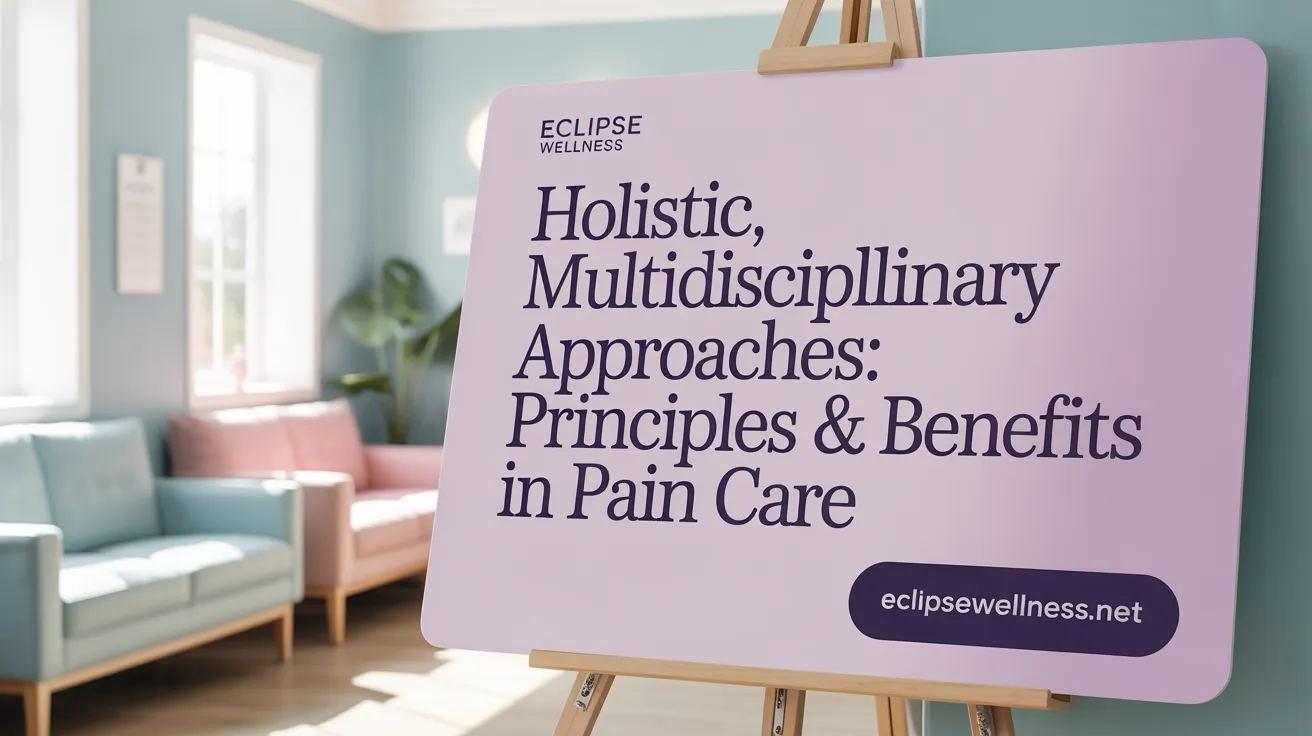Understanding Integrative Care in Chronic Pain Management
Integrative care for chronic pain is reshaping how patients and clinicians approach pain relief by combining conventional medicine with complementary therapies. This whole-person model addresses the biological, psychological, and social dimensions of pain to improve patient outcomes beyond what medications alone can achieve. As the opioid epidemic continues to challenge healthcare systems, integrative strategies offer promising alternatives that prioritize safety, effectiveness, and patient empowerment. This article explores the foundations, therapies, evidence, research, and future directions of integrative care in managing chronic pain.
What Is Integrative Care and How Does It Manage Chronic Pain?
 Integrative care is a comprehensive approach to managing chronic pain that combines traditional medical treatments with evidence-based complementary therapies. It aims to treat the person as a whole, addressing not just physical symptoms but also psychological, social, and environmental factors that contribute to pain.
Integrative care is a comprehensive approach to managing chronic pain that combines traditional medical treatments with evidence-based complementary therapies. It aims to treat the person as a whole, addressing not just physical symptoms but also psychological, social, and environmental factors that contribute to pain.
In practice, integrative care incorporates a variety of modalities such as acupuncture, massage therapy, mindfulness meditation, yoga, tai chi, and dietary supplements. These therapies have demonstrated benefits in reducing pain severity, improving function, and enhancing overall well-being. For example, acupuncture has been shown to help manage back pain and osteoarthritis, while practices like yoga and tai chi are effective for conditions such as fibromyalgia and joint pain.
This approach is highly patient-centered, involving a multidisciplinary team including physicians, physical therapists, behavioral health specialists, and community health workers. Together, they develop personalized treatment plans that align with the patient’s preferences and goals, promoting active participation in the healing process.
The emphasis on nonpharmacologic strategies within integrative care aims to reduce dependence on opioids and other medications. Evidence-based guidelines now recommend treatments like acupuncture, mindfulness, and movement therapies as first-line options for conditions like chronic low-back pain. These modalities address pain's complex biopsychosocial nature, targeting underlying mechanisms rather than just symptoms.
By focusing on whole-person health, integrative care fosters safer, more sustainable pain management outcomes. This approach not only alleviates discomfort but also supports improved mental health, functional capacity, and quality of life, making it a promising pathway forward in personalized, effective chronic pain treatment.
Alternative and Complementary Therapies: Effectiveness and Applications

What are some alternative and complementary therapies used in integrative pain management, and how effective are they?
Integrative pain management often incorporates various alternative and complementary therapies alongside traditional medicine. These approaches aim to treat the whole person by addressing physical, mental, and emotional components of pain.
Common therapies include acupuncture, massage therapy, yoga, osteopathic manipulative treatment (OMT), tai chi, and mindfulness practices. Evidence from numerous clinical studies supports their effectiveness.
Acupuncture, including thread-embedding techniques, has been shown to reliably decrease chronic lower back pain and osteoarthritis symptoms. It is recommended by clinical guidelines and is considered safe, with minimal adverse effects. Tai chi, a gentle movement and meditation practice, is strongly advised for osteoarthritis management, improving pain, stiffness, and balance.
Massage therapy offers short-term relief for conditions like neck and back pain. It enhances blood flow and relaxes the nervous system, often improving function and reducing pain severity.
Yoga has proven benefits for chronic neck and back pain, with effects that can last up to a year. It combines physical postures, breathing, and meditation, which collectively promote flexibility, strength, and mental well-being.
Osteopathic manipulative treatment (OMT) and spinal manipulation therapy (SMT) are hands-on techniques specifically used to treat mechanical pain, including low back pain. Supported by clinical trials, these treatments are effective and generally safe.
Mindfulness practices such as mindfulness-based stress reduction focus on breathing and present-moment awareness, helping lower pain intensity and enhance daily functioning.
Overall, these therapies are safe when used appropriately and can serve as valuable adjuncts to conventional care. They help reduce reliance on opioids and emphasize a holistic, person-centered approach to managing chronic pain.
Evidence-Based Nonpharmacologic Therapies and Their Role in Pain Management

What evidence-based nonpharmacologic therapies exist for pain management?
A variety of evidence-supported non-drug approaches are available to help manage pain effectively. Physical therapies, such as massage, acupuncture, manual therapies like osteopathic and spinal manipulation, and movement-based practices like yoga, tai chi, and qigong, have demonstrated benefits in reducing pain severity. Specific conditions such as chronic low back pain, osteoarthritis, and fibromyalgia often see improvements with these methods, which generally produce small to medium effects.
Psychological approaches are equally valuable. Techniques including cognitive-behavioral therapy (CBT), acceptance and commitment therapy, and mindfulness-based interventions have shown moderate success. These strategies work by addressing emotional and behavioral factors contributing to pain, improving how individuals perceive and cope with their symptoms.
Emerging therapies like neuromodulation and extended reality (XR) are gaining attention. Repetitive transcranial magnetic stimulation (rTMS) and transcranial direct current stimulation (tDCS) offer promising results for specific pain conditions, although evidence remains limited and ongoing research continues to refine their use.
XR therapies, including virtual reality (VR), have shown capacity to create immersive distraction environments that modestly decrease pain levels during painful procedures or chronic conditions. Expectation management, which involves fostering positive belief in treatment efficacy, also plays a role in enhancing outcomes.
Importantly, these therapies are associated with a lower risk profile compared to opioids or other pharmacologic options. They can reduce the risks of adverse long-term outcomes such as substance use disorders, suicidal thoughts, and self-harm. When integrated into a comprehensive pain management plan, these nonpharmacologic strategies offer safe, effective alternatives that align with efforts to minimize medication dependence and support holistic healing.
Holistic, Multidisciplinary Strategies: Principles and Benefits

What are the principles and benefits of holistic, multidisciplinary strategies in managing chronic pain?
Holistic, multidisciplinary strategies in managing chronic pain focus on integrating multiple healthcare approaches to treat the person as a whole. This involves collaboration among different types of healthcare providers such as doctors, physical therapists, psychologists, social workers, and alternative medicine practitioners.
The core principle is to address not only the physical discomfort but also the psychological, emotional, and social factors that contribute to pain. This comprehensive view helps in creating personalized treatment plans tailored to each patient’s specific needs.
By combining diverse treatments like medications, physical therapy, cognitive-behavioral therapy, acupuncture, massage, yoga, and mindfulness techniques, these strategies aim to improve physical function and reduce reliance on opioids or other medications. The goal is to achieve better pain control and enhance quality of life.
These approaches also promote patient engagement, encouraging individuals to take an active role in their healing process. Increased involvement boosts satisfaction and self-management skills, leading to more sustainable outcomes.
Implementing holistic, multidisciplinary care requires proper training for healthcare providers, recognition of chronic pain as a complex disease, and the development of standardized guidelines. Such frameworks ensure coordinated, effective treatment that considers all aspects of the patient’s health.
Recent research highlights the positive impacts of these approaches, showing reductions in pain severity, improved function, and decreased medication use. Overall, embracing a biopsychosocial model through interdisciplinary collaboration offers a promising path forward in managing persistent pain more safely and effectively.
Scientific Research, Initiatives, and Future Trends in Integrative Pain Care

What scientific research and initiatives currently support integrative pain care?
Recent scientific efforts are focused on understanding the complexities of chronic pain through studies of neurobiology, natural products, and biomarkers. The NIH's HEAL (Helping to End Addiction Long-term) initiative and the NIH Pain Management Collaboratory fund extensive clinical trials and infrastructure to evaluate innovative therapies like acupuncture, mindfulness, yoga, and biofeedback. The NCCIH (National Center for Complementary and Integrative Health) explores how natural remedies and mind-body practices work, emphasizing practical implementation to decrease reliance on opioids.
Organizations like the International Association for the Study of Pain (IASP) promote global collaboration, education, and dissemination of research findings, helping translate scientific advances into clinical practices. These initiatives aim to validate effective integrative approaches, develop personalized interventions, and expand access to multimodal pain management, especially for diverse populations.
How do integrative therapies contribute to addressing the opioid epidemic by reducing reliance on pharmacologic treatments?
Integrative therapies offer effective non-drug options that help reduce the need for opioids in managing chronic pain. Treatments such as acupuncture, massage therapy, music interventions, and mind-body techniques like meditation and hypnosis have been shown to lessen pain and improve emotional well-being.
Mechanistically, these modalities stimulate the release of endogenous pain-relief chemicals and modulate pain pathways in the brain. Using such approaches within comprehensive, multimodal pain strategies diminishes opioid reliance, decreasing risks like addiction, overdose, and adverse side effects.
Public education initiatives further support this shift by raising awareness of these therapies. Promoting their benefits encourages patients and healthcare providers to adopt safer, holistic pain management options, ultimately addressing one of the core causes of the opioid crisis.
What educational resources exist for healthcare providers and patients regarding integrative pain management options?
Various educational materials are available to enhance understanding of integrative pain treatments. Clinical guidelines and decision aids provide evidence-based information on options including aromatherapy, virtual reality, acupressure, and pain journaling.
Institutions such as the University of Florida College of Medicine–Jacksonville have developed comprehensive pain education programs, featuring downloadable guides and assessment tools. These resources support healthcare professionals across disciplines, helping them incorporate nonpharmacologic treatments into routine practice.
Moreover, organizations offer online curricula, interprofessional training modules, and community workshops that foster competency in holistic care, reduce stigma, and promote patient-centered approaches. These educational tools are essential for advancing integrated, biopsychosocial pain management.
What are the future prospects and evolving trends in integrative pain management?
Emerging trends in pain care revolve around integrating cutting-edge technology like virtual and augmented reality, wearable devices, and artificial intelligence (AI). These innovations facilitate personalized, adaptive treatments, and continuous monitoring of patient progress.
Future therapies may include neuroplasticity-based interventions, regenerative medicine, and even psychedelics, expanding the spectrum of non-pharmacologic options. AI-driven analytics are expected to improve real-time pain prediction, tailor therapies dynamically, and enhance autonomous neuromodulation techniques.
Overall, the future of integrative pain management emphasizes multidisciplinary, patient-centered care that leverages technological advancements. This approach aims to improve efficacy, safety, and accessibility, ultimately transforming how chronic pain is understood and treated.
Charting a Path Forward with Integrative Pain Care
Integrative care presents a transformative path for managing chronic pain by embracing a whole-person approach that combines evidence-based complementary therapies with conventional treatments. Grounded in multidisciplinary collaboration, scientific research, and patient-centered principles, this model enhances outcomes while addressing the significant challenges posed by opioid reliance. With growing educational resources and advancing technologies, integrative pain management offers hope for safer, more effective, and personalized relief. As research and clinical practices evolve, healthcare providers and patients alike can look forward to a future where chronic pain is managed with compassion, innovation, and holistic strategies that restore quality of life.
References
- The Benefits of Integrative Medicine in the Management ...
- Integrative Pain Management
- Integrative Therapies to Help Manage Chronic Pain
- Chronic Pain and Complementary Health Approaches
- 5 alternative treatments for chronic pain
- The People's Community Clinic's Integrative Pain ...
- How integrative health research tackles the pain management ...
